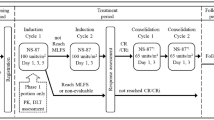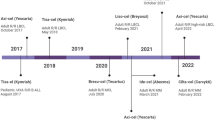Abstract
Purpose. AlbugraninTM fusion protein is recombinant granulocyte colony stimulating factor (rG-CSF) genetically fused at its N-terminus to the C-terminus of recombinant serum human albumin and is expected to have a relatively long half-life compared with rG-CSF alone. In this study, the pharmacodynamics and pharmacokinetics of Albugranin were evaluated in BDF1 mice and cynomolgus monkeys.
Methods. Single doses of Albugranin (0.25-5 mg/kg) or Filgrastim (methionyl rG-CSF, 0.25, or 1.25 mg/kg) were administered subcutaneously (SC) to mice and multiple doses of Albugranin (25-100 μg/kg every 4 or 7 days) or Filgrastim (5 μg/kg daily) were administered SC for 14 days to monkeys for hematologic evaluation. For pharmacokinetics studies, mice were injected intravenously (IV) or SC with single doses of Albugranin (0.25-1.25 mg/kg) or Filgrastim (0.25 mg/kg) and monkeys were injected SC with multiple doses of Albugranin (100-1000 μg/kg once weekly for 5 weeks). Plasma levels of Albugranin and Filgrastim were measured by enzyme-linked immunosorbent assay.
Results. In mice, administration of Albugranin effectively increased the number of peripheral granulocytes and mobilized hematopoietic progenitor cells for up to 5 days. The magnitude and duration of this effect were dose-dependent. In contrast, administration of Filgrastim resulted in a small increase in both cell types on day 1 only. Albugranin administered to cynomolgus monkeys caused an increase in peripheral neutrophils, with a less prominent increase in peripheral monocytes. Albugranin-induced neutrophilia peaked 24 h following each dose administration. Administration of Filgrastim daily in monkeys resulted in moderate increases in neutrophils that were maximal on days 8-12 during the course of treatment. Compared with Filgrastim, Albugranin had a longer terminal half-life (t1/2,term), and mean residence time (MRT), and slower clearance (CL/F) in mice. The t1/2,term, MRT, and CL/F of Albugranin following SC administration to BDF1 mice were 5.6-5.7 h, 16.7-20.7 h, and 6.37-12.2 mL/h/kg, respectively, compared with 2.54 h, 4.9 h, and 164 mL/h/kg, respectively for Filgrastim. In cynomolgus monkeys, the corresponding values of t1/2,term, MRT, and CL/F for Albugranin were 7.73-13.3 h, 19.4-27.3 h, and 7.90-27.5 mL/h/kg, respectively, for doses of 100-1000 μg/kg. An exposure-response relationship that could be empirically described with a simple Emax model with baseline was found between day 15 absolute neutrophil count and area under the curve following the first dose in cynomolgus monkeys.
Conclusion. The sustained activity of Albugranin in mice and monkeys demonstrated in these studies suggests that this agent could be given less frequently than Filgrastim to achieve similar therapeutic effects in patients.
Similar content being viewed by others
REFERENCES
A. W. Roberts and N. A. Nicola. Granulocyte colony-stimulating factor. In: J. M. Garland, P. J. Quesensberry, and D.J. Hilton (eds.), Colony stimulating factors: Molecular and cellular biology. Marcel Dekker Inc., 1997 pp. 203-225.
K. Welte, J. Gabrilove, M. H. Bronchud, E. Platzer, and G. Morstyn. Filgrastim (r-metHuG-CSF). The first 10 years. Blood 88:1907-1929 (1996).
Neupogen® (Filgrastim) [package insert]. Thousand Oaks, Calif.: Amgen, Inc.; 2001.
E. Johnston, J. Crawford, S. Blackwell, T. Bjurstrom, P. Lockbaum, L. Roskos, B. B. Yang, S. Gardner, M. A. Miller-Messana, D. Shoemaker, J. Garst, and G. Schwab. Randomized, doseescalation study of SD/01 compared with daily filgrastim in patients receiving chemotherapy. J.Clin.Oncol. 18:2522-2528 (2002).
P. Viens, C. Chabannon, P. Pouillard, M. Janvier, W. Brugger, J. Y. Blay, F. Oberling, R. Capdeville, C. Newman, V. Meresse, Z. X. Xu, E. Platzer, P. Van der Auwera, and D. Maraninchi. Randomized, controlled, dose-range study of Ro 25-8315 given before and after a high-dose combination chemotherapy regimen in patients with metastatic or recurrent breast cancer patients. J.Clin.Oncol. 20:24-36 (2002).
P. Yeh, D. Landais, M. Lemaitre, I. Maury, J. Y. Crenne, J. Becquart, A. Murry-Brelier, F. Boucher, G. Montay, R. Fleer, P. H. Hirel, J. F. Mayaux, and D. Klatzmann. Design of yeastsecreted albumin derivatives for human therapy: Biological and antiviral properties of a serum albumin-CD4 genetic conjugate. Pro.Natl.Acad.Sci.USA 89:1904-1908 (1992).
G. de Haan, A. Ausema, M. Wilkens, G. Molineux, and B. Dontje. Efficient mobilization of haematopoietic progenitors after a single injection of pegylated recombinant human granulocyte colony-stimulating factor in mouse strains with distinct marrow-cell pool sizes. Br.J.Haematol. 110:638-646 (2000).
G. Molineux, O. Kinstler, B. Briddell, C. Hartley, P. McElroy, P. Kerzic, W. Sutherland, G. Stoney, B. Kern, F. A. Fletcher, A. Cohen, E. Korach, T. Ulich, I. McNiece, P. Lockbaum, M. A. Miller-Messana, S. Gardner, T. Hunt, and G. Schwab. A new form of Filgrastim with sustained duration in vivo and enhanced ability to mobilize PBPC in both mice and humans. Exp.Hematol. 27:1724-1734 (1999).
B. I. Lord, L. B. Woolford, and G. Molineux. Kinetics of neutrophil production in normal and neutropenic animals during the response to Filgrastim (r-metHu G-CSF) or Filgrastim SD/01 (PEG-r-metHu G-CSF). Clin.Cancer Res. 7:2085-2090 (2001).
T. Kuwabara, Y. Kato, S. Kobayashi, H. Suzuki, and Y. Sugiyama. Nonlinear pharmacokinetics of a recombinant human granulocyte colony-stimulating factor derivative (nartograstim): species differences among rats, monkeys and humans. J.Pharmacol.Exp.Ther. 271:1535-1543 (1994).
H. Tanaka and T. Kaneko. Pharmacokinetics of recombinant human granulocyte colony-stimulating factor in mice. Blood 79:536-539 (1992).
X. W. Liu and Z. M. Tang. Pharmacokinetics of recombinant human granulocyte colony-stimulating factor in rabbits and mice. Zhongguo Yao Li Xue Bao 18:44-48 (1997).
J. F. Eliason, A. Greway, N. Tare, T. Inoue, S. Bowen, M. Dar, M. Yamasaki, M. Okabe, and I. Horii. Extended activity in cynomolgus monkeys of a granulocyte colony-stimulating factor mutein conjugated with high molecular weight polyethylene glycol. Stem Cells 18:40-45 (2000).
T. Peters. All About Albumin, Academic Press, San Diego, California, 1996.
H. Takatani, H. Soda, M. Fukuda, M. Watanabe, A. Kinoshita, T. Nakamura, and M. Oka. Levels of recombinant human granulocyte colony-stimulating factor in serum are inversely correlated with circulating neutrophil counts. Antimicrob.Agents Chemother. 40:988-991 (1996).
B. Wang, T. M. Ludden, E. N. Cheung, G. G. Schwab, and L. K. Roskos. Population pharmacokinetic-pharmacodynamic modeling of Filgrastim (r-metHuG-CSF) in healthy volunteers. J.Pharmacokinet.Pharmacodyn. 28:321-341 (2001).
Author information
Authors and Affiliations
Corresponding author
Rights and permissions
About this article
Cite this article
Halpern, W., Riccobene, T.A., Agostini, H. et al. AlbugraninTM, a Recombinant Human Granulocyte Colony Stimulating Factor (G-CSF) Genetically Fused to Recombinant Human Albumin Induces Prolonged Myelopoietic Effects in Mice and Monkeys. Pharm Res 19, 1720–1729 (2002). https://doi.org/10.1023/A:1020917732218
Issue Date:
DOI: https://doi.org/10.1023/A:1020917732218




